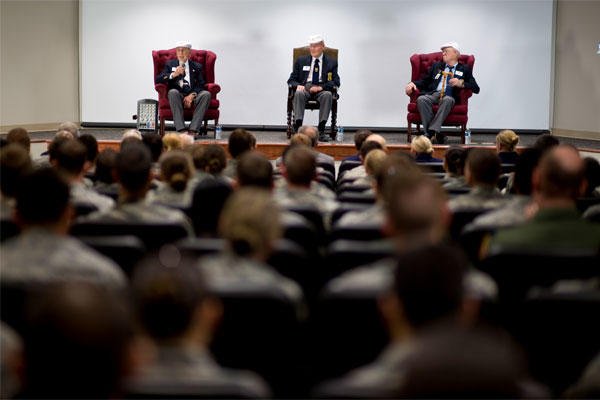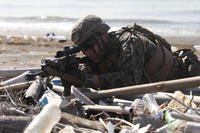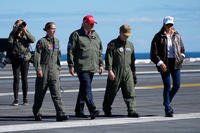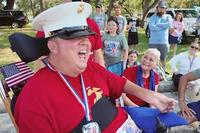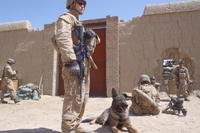HURLBURT FIELD, Fla. -- Three Air Force legends spoke to dozens of Airmen April 18 here, marking the 71st anniversary of when they and their fellow Airmen turned the tide of the U.S. war effort. The visit also marked the last public reunion of the Doolittle Raiders.
Retired Lt. Cols. Richard Cole and Edward Saylor and former Staff Sgt. David Thatcher served alongside 77 fellow tU.S. Army Air Corps Airmen taking off in 16 B-25s in the April 18, 1942, bombing over Japan known as the Doolittle Raid.
The raid, designed and led by then-Lt. Col. James Doolittle, served as the first air raid by the U.S. military in response to the Dec. 7, 1941, Japanese attack on Pearl Harbor, while both bolstering the morale of the American public and instilling doubt among the Japanese people.
"This is a once-in-a-lifetime opportunity," said Col. William Holt, vice commander of the 1st Special Operations Wing, before introducing the Raiders. "In my 22 years in the Air Force, I never imagined I'd be standing in front of three Doolittle Raiders. Without a doubt, this is the highest honor I've had."
After the three Raiders entered the squadron through a sword cordon from the Hurlburt Field Honor Guard, the Airmen in the audience opened the discussion by asking questions about their memories and impression of the raid's chief architect.
"Colonel Doolittle was a very persuasive individual," said Cole, who also served as his co-pilot on the lead aircraft. "He was very charming. He treated everyone with respect and was very polite. He was a team person, and it vibrated throughout all 80 people."
Cole also described Doolittle's dedication to his Airmen as a testament to his leadership.
"Outside of being in awe of him and being able to fly with him, we observed the way he treated his people," he said. "For instance, he would go to an air base and would not leave the airplane until the crew chief had finished gassing it up and doing the things that needed to be done. He'd make sure the crew chiefs were taken to their barracks before he was taken to his. It indicated to me that he treats his people in a very, very polite way."
Prior to leaving the continental U.S., the Raiders spent a portion of the training for the mission at what is now Eglin Air Force Base, Fla., for three weeks of intensive training in March 1942. Given the base's proximity to the water, one Airman asked if the three had any downtime to enjoy the Emerald Coast.
"We did not receive any time off," Cole said. "We were based in quarters and not allowed to go off the base."
The questions then turned to how the Raiders personally prepared for the mission -- an element the team said they had little time to react to but enough resolve to ultimately see it through.
"When they presented the request for volunteers, we were given no information other than it was a dangerous mission," Cole said. "We were practicing takeoffs and so forth. It was very obvious we were going to takeoff from a carrier. We thought we were being transported to some place with a different carrier so we could takeoff and go to an island some place in the Pacific and land and start fighting the war."
"When they announced over the loudspeaker our target was Japan, there was a huge shock that went all over the carrier," said Thatcher, who served as an engineer and gunner in the raid. "No one knew where we were supposed to go, especially the Navy personnel."
"We all volunteered, and I went not knowing what it was," said Saylor, then an engineer. "My feeling was that I hope I could do the job as well as it needed to be done. The responsibility of the airplane was very heavy on my mind. That's how I felt about going in -- I hope I could do the job."
The air raid stormed over the Japanese island of Honshu, with none of the U.S. aircraft being gunned down. While heading across the East China Sea, the Raiders faced harsh conditions both during the flight and in their crash landings in China and the then-Soviet Union, especially under the threat of possible capture by enemy forces.
"I would advise you to be prepared as much as possible for any situation," Thatcher said. "We were in a situation we didn't have any control over. We crash landed on a Japanese-occupied island. There were no Japanese there at the time, and the Chinese Underground who were working on that island helped us escape."
News of the raid's success quickly reached American news outlets, rejuvenating the country's morale for the budding war effort. However, the Raiders said many did not know of their reception in their homeland until years later.
"When I came home, the sense that the whole country was gung-ho to get on with the job -- it was a pretty good feeling," Saylor said.
Shortly after the raid's completion, Doolittle, who had been promoted to brigadier general and received the Medal of Honor from President Franklin D. Roosevelt, had the idea for a reunion among all the surviving Raiders, Cole said.
"Each day after the mission was over (Doolittle) said he was going to throw a party like one we'd never been to before," Cole said. "In 1945, the first party was at McFadden-Deauville Hotel in Miami. The people who were able to come came to it. The party grew to talking and conversations, and somebody suggested 'Why don't we do this every year?' And then Doolittle said 'Wait a minute, fellas -- I'm paying out a lot of money here!'"
Eventually, the reunions led to visiting bases and cities throughout the country. The gatherings soon began awarding out Traffic Safety Awards and recognition to deserving Airmen and later evolved into providing scholarships for local students beginning in 1962, Cole said.
As the session came to a close and the Raiders prepared for their final reunion weekend in Fort Walton Beach, Fla., Saylor concluded by giving his endorsement of the men and women who followed in their footsteps by serving in the Air Force today.
"I look this gang over, and I think we're in good hands," Saylor said. "I want to make sure we give you guys everything you need to get the job done. I'm hopeful."
Cole, an Ohio native, enlisted in the Army Air Corps in November 1940 and received his pilot's commission in July 1941. After serving in the Doolittle Raid, he continued to serve in the Burma-Indo-China theater as one of the original Air Commandos. He is the recipient of Distinguished Flying Cross with two oak leaf clusters, Air Medal with one oak leaf cluster, Bronze Star Medal, Air Force Commendation Medal and Chinese Army, Navy, Air Corps Medal, Class A, 1st Grade.
Saylor graduated high school in Montana and enlisted Dec. 7, 1939. He served both in the United States and overseas throughout the war until March 1945. He accepted a commission as an aircraft maintenance officer in October 1947. He is the recipient of Distinguished Flying Cross, Air Force Commendation Medal and the Chinese Army, Navy, and Air Corps Medal, Class A, 1st Grade.
Thatcher graduated high school and enlisted in December 1940. After the raid, he served in England, Africa and California before being discharged from active duty in July 1945. He is the recipient of the Silver Star Medal, Distinguished Flying Cross, Air Medal with four oak leaf clusters and the Chinese Army, Navy, and Air Corps Medal, Class A, 1st Grade.
All three Raiders were present for their final reunion parade in Fort Walton Beach April 20.
